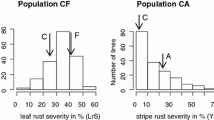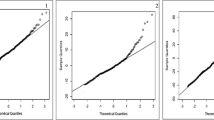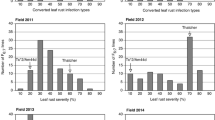Summary
Eighteen populations, composed of four wheat (Triticum aestivum) varieties that were originally mixed together at equal frequencies, were grown for one-to-three generations at two locations. In addition, pure stands of the four varieties were grown in each year. Populations were either exposed to two stripe rust (Puccinia striiformis) races, protected from stripe rust, or exposed to alternating years of diseased and disease-free conditions. Regression of the logit of a variety's frequency versus generation number was used to calculate the relative fitness of each variety in each population. These analyses suggest that the relative fitnesses of the wheat varieties were affected by disease and geographic location and were constant over time. However, frequency-changes of varieties in the mixtures were negatively correlated with their planting frequencies (0.0001 < P < 0.085 in 14 out of 16 cases), suggesting that fitnesses were frequency-dependent in both the presence and absence of disease. We hypothesize that failure to detect frequency-dependence of fitness in the logit analyses was due to a limited number of generations and a limited range of initial variety frequencies. This is supported by data from longer-term studies in the literature that provide evidence for frequency-dependence of fitness in plant mixtures. Analyses of currently available field data suggest that stable equilibria may be a more likely outcome for mixtures of varieties that are more closely related and/or more uniformly adapted to the environment in which they are grown.
Similar content being viewed by others
References
Alexander HM (1984) Spatial patterns of disease induced by Fusarium moniliforme var. subglutinans in a population of Plantago lanceolata. Oecologia 62:141–143
Alexander HM (1991) Plant population heterogeneity and pathogen and herbivore levels: a field experiment. Oecologia 86:125–131
Alexander HM, Burdon JJ (1984) The effect of disease induced by Albugo Candida (white rust) and Peronospora parasitica on the survival and reproduction of capsella bursa-pastoris. Oecologia 64:314–318
Alexander HM, Roelfs AP, Cobbs G (1986) Effects of disease and plant competition in monocultures and mixtures of two wheat cultivars. Plant Pathol 35:457–465
Augspurger CK (1984) Seedling survival of tropical tree species: Interactions of dispersal distance, light-gaps, and pathogens. Ecology 65:1705–1712
Augspurger CK, Kelly CK (1984) Pathogen mortality of tropical tree seedlings. Experimental studies of the effects of dispersal distance, seedling density, and light conditions. Oecologia 61:211–217
Blijenburg JG, Sneep J (1975) Natural selection in a mixture of eight barley varieties grown in six successive years. 1. Competition between the varieties. Euphytica 24:305–315
Browning JA, Frey KJ (1969) Multiline cultivars as a means of disease control. Annu Rev Phytopathol 7:355–382
Burdon JJ, Chilvers GA (1976) Controlled environment experiments on epidemics of barley mildew in different density host stands. Oecologia 26:61–72
Burdon JJ, Chilvers GA (1982) Host density as a factor in plant disease ecology. Annu Rev Phytopathol 20:143–166
Burdon JJ, Groves RH, Cullen JM (1981) The impact of biological control on the distribution and abundance of Chondrilla juncea in south-eastern Australia. J Appl Ecol 18:957–966
Burdon JJ, Groves RH, Kaye PE, Speer SS (1984) Competition in mixtures of susceptible and resistant genotypes of Chondrilla juncea differentially infected with rust. Oecologia 64:199–203
Chilvers GA, Brittain EG (1972) Plant competition mediated by host-specific parasites — a simple model. Aust J Biol Sci. 25:749–756
Chin KM, Wolfe MS (1984) Selection on Erysiphe graminis in pure and mixed stands of barley. Plant Pathol 33:535–546
Clay K (1984) The effect of the fungus Atkinsonella hypoxylon (Clavicipitaceae) on the reproductive system and demography of the grass Danthonia spicata. New Phytol 98:165–175
Falconer DS (1981) Introduction to quantitative genetics, 2nd edn. Longman Scientific and Technical, Wiley, New York
Finckh MR, Mundt CC (1992a) Stripe rust, yield, and plant competition in wheat cultivar mixtures. Phytopathology 82:905–913
Finckh MR, Mundt CC (1992 b) Plant competition and disease in genetically diverse wheat populations. Oecologia 91:82–92
Firbank LG, Watkinson AR (1985) on the analysis of competition within two-species mixtures of plants. J Appl Ecol 22:503–517
Flor HH (1953) Epidemiology of flax rust in the North Central States. Phytopathology 43:624–628
Gates DJ, Westcott M, Burdon JJ, Alexander HM (1986) Competition and stability in plant mixtures in the presence of disease. Oecologia 68:559–566
Hamblin J (1975) Effect of environment, seed size, and competitive ability on yield and survival of Phaseolus vulgaris (L.) genotypes in mixtures. Euphytica 24:435–445
Harlan HV, Martini MI (1938) The effect of natural selection in a mixture of barley varieties. J Agric Res 57:189–199
Jarosz AM, Eevy M (1988) Effects of habitat and population structure on powdery mildew epidemics in experimental phlox populations. Phytopathology 78:358–362
Jarosz AM, Burdon JJ, Mueller WJ (1989) Longterm effects of disease epidemics. J Appl Ecol 26:725–733
Jennings PR, de Jesus J Jr (1968) Studies on competition in rice. I. Competition in mixtures of varieties. Evolution 22:119–124
Johnson T, Green GJ, Samborski DJ (1967) The world situation of the cereal rusts. Annu Rev Phytopathol 5:183–200
Jolliffe PA, Minjas AN, Runeckles VC (1984) A reinterpretation of yield relationships in replacement series experiments. J Appl Ecology 21:227–243.
Kilen TC, Keeling BL (1990) Gene frequency changes in soybean bulk populations exposed to Phytophthora rot. Crop Sci 30:575–578
Leonard KJ (1969a) Factors affecting rates of stem rust increase in mixed plantings of susceptible and resistant oat varieties. Phytopathology 59:1845–1850
Leonard KJ (1969 b) Selection in heterogeneous populations of Puccinia graminis f. sp. avenae. Phytopathology 59:1851–1857
Leonard KJ (1977) Virulence, temperature optima, and competitive abilities of isolines of races T and O of Bipolaris maydis. Phytopathology 67:1273–1279
Leonard KJ, Czochor RJ (1980) Theory of genetic interactions among populations of plants and their pathogens. Annu Rev Phytopathol 18:337–358
May RM, Anderson RM (1983a) Epidemiology and genetics in the coevolution of parasites and hosts. Proc Roy Soc London, Ser. B 219:281–313
May RM, Anderson RM (1983b) Parasite-host coevolution. In: Futuyma DJ, Slatkin M (eds) Coevolution. Sinauer, pp 186–206
McDonald BA, Allard RW, Webster RK (1988) Responses of two-, three-, and four-component barley mixtures to a variable pathogen population. Crop Sci 28:447–452
McDonald BA, McDermott JM, Allard RW, Webster, RK (1989) Coevolution of host and pathogen populations in the Hordeum vulgare — Rhynchosporium secalis pathosystem. Proc Natl Acad Sci USA 86:3924–3927
Mode CJ (1958) A mathematical model for the co-evolution of obligate parasites and their hosts. Evolution 12:158–165
Mode CJ (1961) A generalized model of a host-pathogen system. Biometrics, 17:386–404
Mundt CC, Browning JA (1985a) Genetic diversity and cereal rust management. In: Roelfs AP, Bushnell WR (eds) The cereal rusts, vol II. Academic Press, Orlando, pp 527–559
Mundt CC, Browning JA (1985 b) Development of crown rust epidemics in genetically diverse oat populations: effect of genotype unit area. Phytopathology 75:607–610
Murphy JP, Hebsel DB, Elliott A, Thro AM, Frey KJ (1982) Compositional stability of an oat multiline. Euphytica 31:33–40
Parker MA (1989) Disease impact and local genetic diversity in the clonal plant Podophyllum peltatum. Evolution 43:540–547
Parker MA (1991) Nonadaptive evolution of disease resistance in an annual legume. Evolution 45:1209–1217
Paul ND (1989) The effects of Puccinia lagenophorae on Senecio vulgaris in competition with Euphorbia peplus. J Ecol 77:552–564
Paul ND, Ayres PG (1986a) Interference between healthy and rusted groundsel within mixed populations of different densities and proportions. New Phytol 104:257–269
Paul ND, Ayres PG (1986 b) The impact of a pathogen (Puccinia lagenophorae) on populations of groundsel (Senecio vulgaris) overwintering in the field. I. Mortality, vegetative growth and the development of size hierarchies. J Ecol 74:1069–1084
Paul ND, Ayres PG (1986 c) The impact of a pathogen (Puccinia lagenophorae) on populations of groundsel (Senecio vulgaris) overwintering in the field. II. Reproduction. J Ecol 74:1085–1094
Paul ND, Ayres PG (1987a) Survival, growth and reproduction of groundsel (Senecio vulgaris) infected by rust (Puccinia lagenophorae) in the field during summer. J Ecol 75:61–71
Paul ND, Ayres PG (1987 b) Effects of rust infection of Senecio vulgaris on competition with lettuce. Weed Res 27:431–441
SAS Institute Inc (1988) SAS/STAT User's Guide edn. 6.03. SAS Institute, Cary, N.C., 1029pp
Spitters CJT (1983) An alternative approach to the analysis of mixed cropping experiments. I. Estimation of competition effects. Neth J Agric Sci 31:1–11
Suneson CA (1949) Survival of four barley varieties in mixture. Agron 141:459–461
Suneson CA, Wiebe GA (1942) Survival of barley and wheat varieties in mixtures. J Am Soc Agron 34:1052–1056
Wahl I (1970) Prevalence and geographic distribution of resistance to crown rust in Avena sterilis. Phytopathology 60:746–749
Webster RK, Saghai-Maroof MA, Allard RW (1986) Evolutionary response of barley composite cross II to Rhynchosporium secalis analyzed by pathogenic complexity and by gene-by-race relationships. Phytopathology 76:661–668
Wolfe MS (1985) The current status and prospects of multiline cultivars and variety mixtures for disease resistance. Annu Rev Phytopathol 23:251–273
Zwer PK (1989) History of club wheat cultivars in the Pacific Northwest. Special report 840, Agricultural Experimental Station, Oregon State University, pp 35–39
Author information
Authors and Affiliations
Additional information
Communicated by G.E. Hart
Paper No. 9820 of the journal series of the Oregon Agricultural Experiment Station.
Rights and permissions
About this article
Cite this article
Finckh, M.R., Mundt, C.C. Effects of stripe rust on the evolution of genetically diverse wheat populations. Theoret. Appl. Genetics 85, 809–821 (1993). https://doi.org/10.1007/BF00225023
Received:
Accepted:
Issue Date:
DOI: https://doi.org/10.1007/BF00225023




